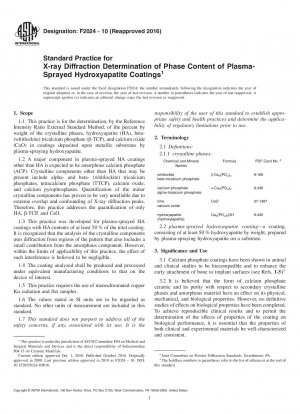ASTM F2024-10(2016)
Standard Practice for X-ray Diffraction Determination of Phase Content of Plasma-Sprayed Hydroxyapatite Coatings
- Standard No.
- ASTM F2024-10(2016)
- Release Date
- 2010
- Published By
- American Society for Testing and Materials (ASTM)
- Status
- Replace By
- ASTM F2024-10(2021)
- Latest
- ASTM F2024-10(2021)
- Scope
3.1 Calcium phosphate coatings have been shown in animal and clinical studies to be biocompatible and to enhance the early attachment of bone to implant surfaces (see Refs. 1-5)3
3.2 It is believed that the form of calcium phosphate ceramic and its purity with respect to secondary crystalline phases and amorphous material have an effect on its physical, mechanical, and biological properties. However, no definitive studies of effects on biological properties have been completed. To achieve reproducible clinical results and to permit the determination of the effects of properties of the coating on biological performance, it is essential that the properties of both clinical and experimental materials be well-characterized and consistent.
3.3 This practice provides procedures for determination of the percentage by weight of the crystalline phases identified as hydroxyapatite, β-TCP and CaO in plasma-sprayed hydroxyapatite coatings.
1.1 This practice is for the determination, by the Reference Intensity Ratio External Standard Method, of the percent by weight of the crystalline phases, hydroxyapatite (HA), beta-(whitlockite) tricalcium phosphate (β-TCP), and calcium oxide (CaO) in coatings deposited upon metallic substrates by plasma-spraying hydroxyapatite.
1.2 A major component in plasma-sprayed HA coatings other than HA is expected to be amorphous calcium phosphate (ACP). Crystalline components other than HA that may be present include alpha- and beta- (whitlockite) tricalcium phosphates, tetracalcium phosphate (TTCP), calcium oxide, and calcium pyrophosphates. Quantification of the minor crystalline components has proven to be very unreliable due to extreme overlap and confounding of X-ray diffraction peaks. Therefore, this practice addresses the quantification of only HA, β-TCP, and CaO.
1.3 This practice was developed for plasma-sprayed HA coatings with HA contents of at least 508201;% of the total coating. It is recognized that the analysis of the crystalline components uses diffraction from regions of the pattern that also includes a small contribution from the amorphous component. However, within the limits of applicability of this practice, the effect of such interference is believed to be negligible.
1.4 The coating analyzed shall be produced and processed under equivalent manufacturing conditions to that on the device of interest.
1.5 This practice requires the use of monochromated copper Kα radiation and flat samples.
1.6 The values stated in SI units are to be regarded as standard. No other units of measurement are included in this standard.
1.7 This standard does not purport......
ASTM F2024-10(2016) history
- 2021 ASTM F2024-10(2021) Standard Practice for X-ray Diffraction Determination of Phase Content of Plasma-Sprayed Hydroxyapatite Coatings
- 2010 ASTM F2024-10(2016) Standard Practice for X-ray Diffraction Determination of Phase Content of Plasma-Sprayed Hydroxyapatite Coatings
- 2010 ASTM F2024-10 Standard Practice for X-ray Diffraction Determination of Phase Content of Plasma-Sprayed Hydroxyapatite Coatings
- 2000 ASTM F2024-00 Standard Practice for X-ray Diffraction Determination of Phase Content of Plasma-Sprayed Hydroxyapatite Coatings

Copyright ©2024 All Rights Reserved